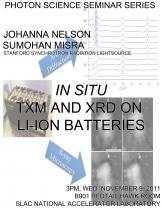Speaker: Johanna Nelson (SSRL), Sumohan Misra (SSRL)
Program Description
A key factor in the global move towards clean, renewable energy is the electrification of the automobile. Current battery technology limits EV (electric vehicles) to a short travel range, slow recharge, and costly price tag. Li-ion batteries promise the high specific capacity required for EVs to travel 300+ miles on a single charge with a number of possible earth abundant anode and cathode materials; however, set backs such as capacity fading hinder the full capability of these rechargeable batteries. In an effort to accurately characterize the electrochemistry in Li-ion batteries, we have developed a two-pronged approach using in situ transmission X-ray microscopy and in situ X-ray diffraction to track morphological and structural changes during battery operation.





